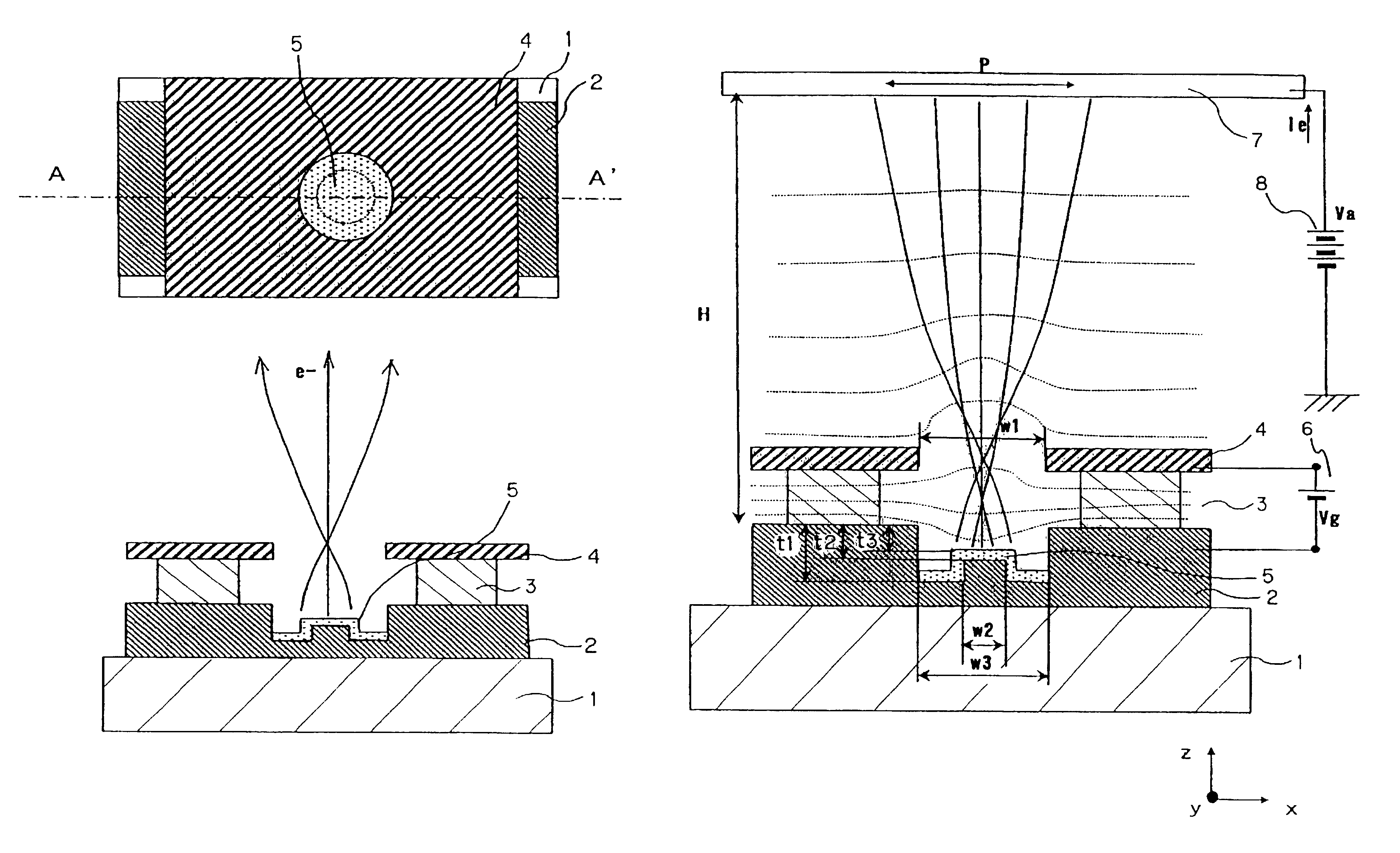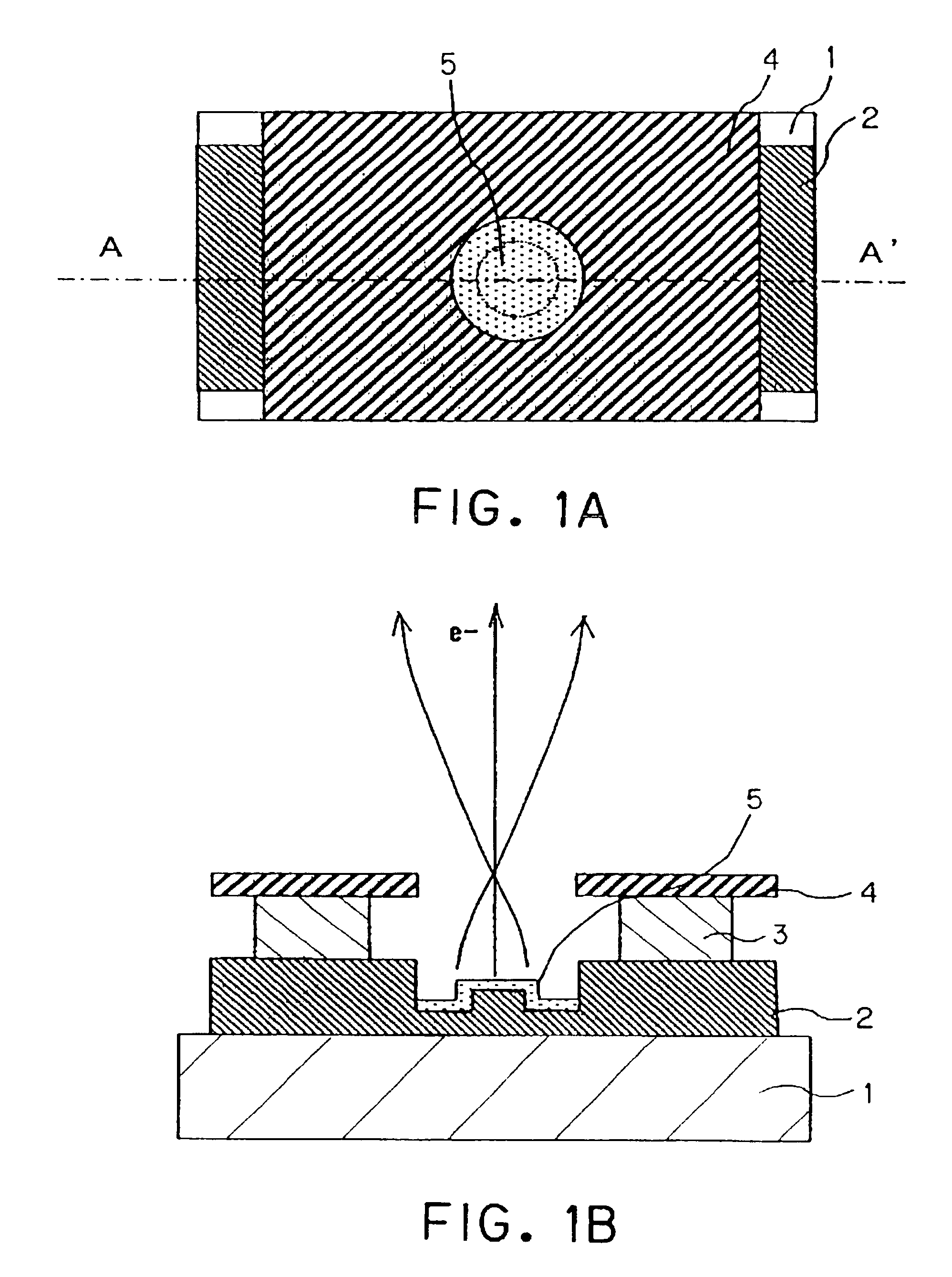Electron-emitting device and image-forming apparatus
a technology of electron-emitting device and image-forming apparatus, which is applied in the manufacture of electric discharge tubes/lamps, tubes with screens, discharge tubes luminescnet screens, etc., and can solve the problems of inability to make small beams, limited lifetime of fe-type devices, and inducing the thermal destruction of electron-emitting portions
- Summary
- Abstract
- Description
- Claims
- Application Information
AI Technical Summary
Benefits of technology
Problems solved by technology
Method used
Image
Examples
embodiment 1
FIGS. 1A and 1B show Embodiment 1 of the present invention. Further, an example of a manufacturing method thereof is shown in FIGS. 4A to 4G. The manufacturing method is explained.
Process 1
First, soda lime glass is used as the substrate 1 as shown in FIG. 4A. Ta is formed to a thickness of 800 nm as the cathode electrode 2 after sufficient washing is performed.
Next, SiO.sub.2 is deposited to a thickness of 500 nm as the insulating layer 3, and Pt is deposited to a thickness of 100 nm as the gate electrode 4 in the stated order.
Process 2
In addition, the Al mask pattern 41 is formed as shown in FIG. 4B by utilizing photolithography.
Process 3
The Pt gate electrode 4 is then etched using Ar plasma etching, and the insulating layer 3 and the cathode electrode 2 are dry etched using CF.sub.4 gas, with the mask pattern 41 acting as a mask, as shown in FIG. 4C. An opening having the width w2 equal to 0.4 .mu.m, the width w3 equal to 1.2 .mu.m, and the cathode electrode 2 opening thickness t1...
embodiment 2
FIG. 10A is a variation example of Embodiment 1, and is an example in which the edge is blunt in the process of manufacturing the cathode electrode 2.
The opening is minute in Embodiment 2, and for cases in which the peripheral portion region cannot be made small compared to the opening, the above-mentioned phenomenon is caused by etching. Manufacturing is performed in Embodiment 2 with the width w3 of the opening of the gate electrode 4 being set to 0.8 .mu.m.
A beam size similar to that of Embodiment 1 can also be obtained in Embodiment 2 by optimizing t3. In this case, it is also possible to manufacture the peripheral portion and the central portion of the opening bottom face of the cathode electrode 2 by also shaving the central portion of the cathode electrode 2 when manufacturing the peripheral portion, and performing the etching process, which must be performed twice in Embodiment 1, only once here.
embodiment 3
FIG. 10B is an example in which the size w1 of the opening of the gate electrode 4 is made smaller than the opening of the cathode electrode 2. In this structure, the electron-emitting material 5 does not exist in the edge portion of the cathode electrode 2, and therefore the leak current of the electron-emitting material 5 can be reduced to nearly zero.
A method of etching by using a focused ion beam from an oblique angle can be considered in etching the peripheral portion as a manufacturing method for forming this structure.
PUM
 Login to View More
Login to View More Abstract
Description
Claims
Application Information
 Login to View More
Login to View More - R&D
- Intellectual Property
- Life Sciences
- Materials
- Tech Scout
- Unparalleled Data Quality
- Higher Quality Content
- 60% Fewer Hallucinations
Browse by: Latest US Patents, China's latest patents, Technical Efficacy Thesaurus, Application Domain, Technology Topic, Popular Technical Reports.
© 2025 PatSnap. All rights reserved.Legal|Privacy policy|Modern Slavery Act Transparency Statement|Sitemap|About US| Contact US: help@patsnap.com



